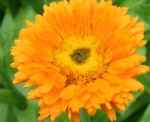 This short lived perennial is native to southern Europe and North Africa but has naturalized in much of Europe where it is grown as an annual. It is a member of the aster family, Asteraceae, that also includes daisies, sunflowers, and lettuce. The aromatic leaves are two to seven inches long and hairy. The single or double flowers are up to four inches across and may be yellow, orange, gold, cream or bicolored with dark centers. They appear from early spring to frost and were believed to be in bloom on the first day of every month, the Kalends in ancient Roman times, hence the genus name, Calendula. In the Middle Ages the plant was called Mary-bud and dedicated to the Virgin Mary because it seemed to always be in bloom on holy days. The flowers provide nectar and pollen for bees and butterflies, and the nectar attracts aphids which in turn attract ladybeetles, hoverflies, and lacewings. The seeds attract small birds in the winter. Although considered easy to grow in almost any kind of soil, pot marigold does not do well where summers are hot. In USDA zones 8-10 pot marigold can be grown for winter color Plants self sow. Both leaves and flowers can be used in cooking although the flowers are preferred.
This short lived perennial is native to southern Europe and North Africa but has naturalized in much of Europe where it is grown as an annual. It is a member of the aster family, Asteraceae, that also includes daisies, sunflowers, and lettuce. The aromatic leaves are two to seven inches long and hairy. The single or double flowers are up to four inches across and may be yellow, orange, gold, cream or bicolored with dark centers. They appear from early spring to frost and were believed to be in bloom on the first day of every month, the Kalends in ancient Roman times, hence the genus name, Calendula. In the Middle Ages the plant was called Mary-bud and dedicated to the Virgin Mary because it seemed to always be in bloom on holy days. The flowers provide nectar and pollen for bees and butterflies, and the nectar attracts aphids which in turn attract ladybeetles, hoverflies, and lacewings. The seeds attract small birds in the winter. Although considered easy to grow in almost any kind of soil, pot marigold does not do well where summers are hot. In USDA zones 8-10 pot marigold can be grown for winter color Plants self sow. Both leaves and flowers can be used in cooking although the flowers are preferred.
Type: Short lived perennial grown as annual
Size: 12” H x 12” W
Light: Full sun to light shade
Soil: Does well in a wide variety of soils
Hardiness: Zones 6-7
Beneficial Insects Attracted: bees, butterflies, ladybeetles, hoverflies, lacewings